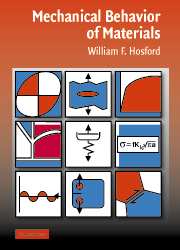Book contents
- Frontmatter
- Contents
- Preface
- Note to the Reader
- 1 Stress and Strain
- 2 Elasticity
- 3 Tensile Testing
- 4 Other Tests of Plastic Behavior
- 5 Strain-Hardening of Metals
- 6 Plasticity Theory
- 7 Strain-Rate and Temperature Dependence of Flow Stress
- 8 Slip
- 9 Dislocation Geometry and Energy
- 10 Dislocation Mechanics
- 11 Mechanical Twinning and Martensitic Shear
- 12 Hardening Mechanisms in Metals
- 13 Ductility and Fracture
- 14 Fracture Mechanics
- 15 Viscoelasticity
- 16 Creep and Stress Rupture
- 17 Fatigue
- 18 Residual Stresses
- 19 Ceramics and Glasses
- 20 Polymers
- 21 Composites
- 22 Mechanical Working
- Appendix A Miller Indices
- Appendix B Stereographic Representation of Orientations
- Index
13 - Ductility and Fracture
Published online by Cambridge University Press: 05 June 2012
- Frontmatter
- Contents
- Preface
- Note to the Reader
- 1 Stress and Strain
- 2 Elasticity
- 3 Tensile Testing
- 4 Other Tests of Plastic Behavior
- 5 Strain-Hardening of Metals
- 6 Plasticity Theory
- 7 Strain-Rate and Temperature Dependence of Flow Stress
- 8 Slip
- 9 Dislocation Geometry and Energy
- 10 Dislocation Mechanics
- 11 Mechanical Twinning and Martensitic Shear
- 12 Hardening Mechanisms in Metals
- 13 Ductility and Fracture
- 14 Fracture Mechanics
- 15 Viscoelasticity
- 16 Creep and Stress Rupture
- 17 Fatigue
- 18 Residual Stresses
- 19 Ceramics and Glasses
- 20 Polymers
- 21 Composites
- 22 Mechanical Working
- Appendix A Miller Indices
- Appendix B Stereographic Representation of Orientations
- Index
Summary
Introduction
Throughout history there has been a never-ending effort to develop materials with higher yield strength. However, a higher yield strength is generally accompanied by a lower ductility and a lower toughness. Toughness is the energy absorbed in fracturing. A high-strength material has low toughness because it can be subjected to higher stresses. The stress necessary to cause fracture may be reached before there has been much plastic deformation to absorb energy. Ductility and toughness are lowered by factors that inhibit plastic flow. As schematically indicated in Figure 13.1, these factors include decreased temperatures, increased strain rates, and the presence of notches. Developments that increase yield strength usually result in lower toughness.
In many ways the fracture behavior of steel is like that of taffy candy. It is difficult to break a warm bar of taffy candy to share with a friend. Even children know that warm taffy tends to bend rather than break. However, there are three ways to promote its fracture. A knife may be used to notch the candy bar, producing a stress concentration. The candy may be refrigerated to raise its resistance to deformation. Finally, rapping it against a hard surface raises the loading rate, increasing the likelihood of fracture. Notches, low temperatures, and high rates of loading also embrittle steel.
There are two important reasons for engineers to be interested in ductility and fracture. The first is that a reasonable amount of ductility is required to form metals into useful parts by forging, rolling, extrusion, or other plastic working processes.
- Type
- Chapter
- Information
- Mechanical Behavior of Materials , pp. 210 - 226Publisher: Cambridge University PressPrint publication year: 2005



